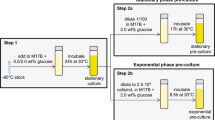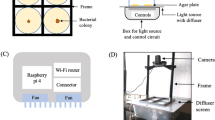Abstract
Exponentially growing cultures of Klebsiella pneumoniae were subjected to heat shocks in the superoptimal and supermaximal temperature ranges for growth on glucose in a defined mineral salts medium. Transitory changes in the specific growth rate constant during recovery were evident. The response was heat shock temperature and exposure time dependent. Cell viability determinations, based on colony counts, indicated complete recovery from heat treatments at superoptimal temperatures. In contrast, at supermaximal temperatures, discrepancies in colony counts on different agars were observed. The kinetic response of the specific growth rate constant after a heat shock at supermaximal temperatures is explained by segregation within the bacterial population
Similar content being viewed by others
References
Anderson Da Silva N, Bailey JE (1989) Construction and characterization of a temperature-sensitive expression system in recombinant yeast. Biotechn Prog 5: 18–26
Daniels CJ, McKee AHZ, Doolittle WF (1984) Archaebacterial heat-shock proteins. EMBO J 3: 745–749
Esener AA, Roels JA, Kossen NWF (1981) The influence of temperature on the maximum specific growth rate of Klebsiella pneumoniae. Biotechn Bioeng 23: 1401–1405
Evans CGT, Herbert D, Tempest DW (1970) The continuous cultivation of microorganisms. In: Norris JR, Ribbons DW (eds) Methods in microbiology, vol 2. Academic Press London, pp 277–327
Franks PA, Hall RJ, Linklater PM (1980) Mechanistic model of the growth of Streptococcus cremoris HP at superoptimal temperatures. Biotechn Bioeng 22: 1465–1487
Hamer G, Heitzer A (1990) Fluctuating environmental conditions in scaled-up bioreactors — heating and cooling effects. Ann N Y Acad Sci in press
Heitzer A, Al-Awadhi N, Hamer G (1989) Some effects of heat shocks on bacterial growth. Appl Microbiol Biotechn 30: 408–414
Herendeen SL, Van Bogelen RA, Neidhardt FC (1979) Levels of major proteins of Escherichia coli during growth at different temperatures. J Bacteriol 139: 185–194
Ingraham J (1987) Effect of temperature, pH, water activity, and pressure on growth. In: Neidhardt FC (ed) Escherichia coli and Salmonella typhimurium: cellular and molecular biology, vol 2. American Society for Microbiology, Washington D.C., pp 1543–1554
Jenkins DE, Schultz JE, Matin A (1988) Starvation-induced cross protection against heat or H2O2 challenge in Escherichia coli. J Bacteriol 170: 3910–3914
Lastick SM, Tucker MY, Mackedonsky V, Grohmann K (1986) Overproduction of E. coli xylose isomerase. Biotechnol Lett 8: 1–6
Podhajska AJ, Hasan N, Szybalski W (1985) Control of cloned gene expression by promoter inversion in vivo: construction of the heat-pulse-activated att-nutL-p-att-N module. Gene 40: 163–168
Ramsay N (1988) A mutant in a major heat shock protein of Escherichia coli continues to show inducible thermotolerance. Mol Gen Genet 211: 332–334
Ryu DY, Mateles RI (1968) Transient response of continuous cultures to changes in temperature. Biotechn Bioeng 10: 385–397
Takano M, Tsuchido T (1982) Availability of growth delay analysis for the evaluation of total injury of stressed bacterial populations. J Ferment Techn 60: 189–198
Van Bogelen RA, Acton MA, Neidhardt FC (1987) Induction of the heat shock regulon does not produce thermotolerance in Escherichia coli. Genes & Development 1: 525–531
Uden N van, Madeira-Lopes A (1976) Yield maintenance relations of yeast growth in the chemostat at superoptimal temperatures. Biotechn Bioeng 18: 791–804
Yamamori T, Yura T (1980) Temperature-induced synthesis of specific proteins in Escherichia coli: Evidence for transcriptional control. J Bacteriol 142: 843–851
Author information
Authors and Affiliations
Rights and permissions
About this article
Cite this article
Heitzer, A., Hamer, G. Recovery of exponentially growing cultures of Klebsiella pneumoniae NCIB 418 after heat shocks. Arch. Microbiol. 153, 272–275 (1990). https://doi.org/10.1007/BF00249081
Received:
Accepted:
Issue Date:
DOI: https://doi.org/10.1007/BF00249081




